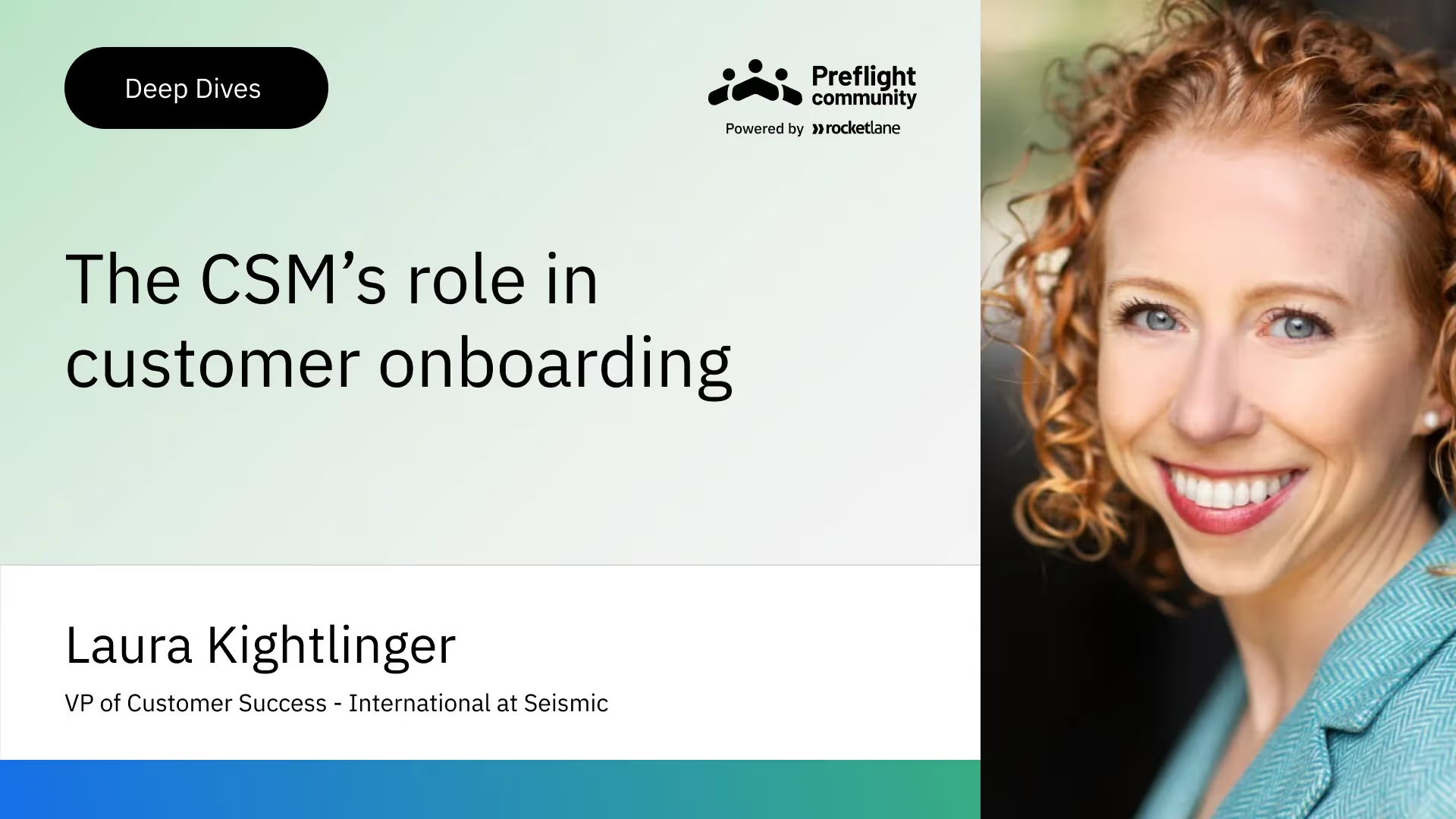In this edition of Deep Dives, we spoke to Laura Kightlinger, the VP of Customer Success - International at Seismic.
She led a detailed session on the roles and responsibilities of a CSM throughout the customer journey. She also gave valuable tips and best practices for successful customer onboarding.
In this session, Laura spoke about:
- What it means to be a CSM
- Implementation vs. Customer Onboarding at Seismic
- The customer journey at Seismic
- The benefits and outcomes of the split workflow approach
- How the Seismic team assesses the success of their implementation and customer onboarding
- Who owns escalation management at Seismic
- Seismic’s ‘train the trainer’ approach
- Advice for one-person CS teams trying to build up processes and standards in a startup
Here are key takeaways from the session.
What does it mean to be a CSM?
The Customer Success Manager (CSM) is key to a successful onboarding process. They shouldn’t limit themselves to just responding to customer requests; they should also take the lead and offer advice. To do this well, CSMs must have domain expertise–they should be able to explain how their products fit into the broader context of the customer's operations and not just talk about how their tool fits in with their customers’ tech stack.
CSMs need to be more than just the 'happy customer factory'. CSMs must act as partners in a long-term, honest relationship with their customers. They shouldn't just make them happy—they should help them be successful too, even if that means being direct or saying no. During customer onboarding, the CSM can assist other teams like Professional Services in guiding the customers. Instead of doing every step for them, the CSM should act as a trusted advisor, setting the customer's path and direction to reach their desired end goal. This end goal should be quantifiable and result in meaningful business outcomes for the customer.
Implementation vs. Customer Onboarding at Seismic
At Seismic, the implementation is viewed as a technical configuration of the product that is a one-time process. However, since the platform is comprehensive, there may be several implementations of different parts of the platform. The main goal is getting the customer onboarded into their ecosystem, which involves not just the technical aspects but also the processes and people involved. The initial setup requires a clear focus on execution. It needs to take into account how the product will fit into the customer's business. This is an opportunity to kick off a long-term partnership and a wider program of work in terms of both process and people.
The Seismic team’s work as their customer’s tech provider doesn’t end after the implementation and product configuration are complete. They need to do more to ensure long-term value: consulting, educating, and providing domain expertise. Thus, the onboarding process and embedding of the customer's business is the responsibility of the customer success team, while the professional services team takes care of the implementation.
However, for smaller startups, it might not be possible to differentiate between these roles. If one person is the CSM, juggling all of the tasks, they need to ensure they're getting multiple aspects of their job done simultaneously. They should strive to create distinct points of contact with those they are working with, some relating to implementation and others to customer onboarding. This way, they can begin to establish themselves as a trusted advisor from the get-go.
The customer journey at Seismic
To ensure an effective customer journey during implementation and onboarding, a strong handoff and introduction from sales are crucial. This conveys the customer's investment and concerns to post-sales teams, establishing clear communication of team roles and responsibilities. A kickoff meeting or email initiates the process, creating a foundation for the customer relationship. The journey is then divided into two workstreams–technical implementation and consultative onboarding–which converge for the go-live and handover.
1. Sales handoff
The post-sales teams need to ensure that customers have a clear idea of who will be responsible for what. An internal debrief should happen between sales and CS/PS before contacting the customer. This way, a smooth transition is ensured, and the customer gets the impression of one unified company speaking to them instead of two separate entities.
In order to ensure a successful handoff from the sales team, some key details need to be covered, like who the main people of contact from the customer team are and their job roles. It's also important to understand how the salesperson wants to work with us and how they worked with us during the sales process. Additionally, what the customer has purchased should be established, especially if there is a wide range of packages available for the product. It is also important to understand why the customer made the purchase, the pain points the product will solve, and the outcomes they hope to achieve. Once this information has been debriefed internally, the salesperson should introduce the relevant PS and CS team members to the customer and explain what roles each of them will take in future steps. This will make it easy for the customer to understand the transition, and after that, either the PS team or the CSM can quickly follow up.
See also: How to create a winning Sales-to-Customer-Success handoff document [Free Template]
2. Kickoff meeting
For the kickoff meeting, the CSM and Professional Services team take on different roles. Introductions are made at the beginning, with each member stating their roles and responsibilities. To keep the customer engaged, it is important to invite all the key stakeholders, including the senior stakeholder who made the purchase with sales. This will ensure their continued involvement throughout the process. During this meeting, a section is led by the CSM to provide a big-picture view of how the partnership will be handled. It is important to ensure that the product meets the customer's expectations and delivers business value. After that, the professional services team can focus on the project and take the necessary steps to get the product up and running and help the customer realize its value.
See also: Pulling Off the Ultimate Kickoff Meeting for A Customer Onboarding Project
After the kickoff meeting, the professional services team will work on technical implementation while the CSM focuses on consultative onboarding with senior stakeholders. Splitting these roles maintains engagement from senior stakeholders during the initial phase, avoiding loss of momentum and difficulties in long-term renewal and expansion.
3. Technical implementation
For technical implementation, the professional services team works hard with the customer to get the system up and running. Typically, a project plan is closely followed, using some kind of project management tool. The professional services team follows a detailed project plan, communicates with the customer regularly on progress, and manages any roadblocks to ensure on-time, on-budget delivery. Onboarding can range from a few weeks for SMB/mid-market customers to 6-12 months for larger global accounts, with milestones along the way. Regardless of the size and complexity of the project, a detailed, bespoke project plan is followed, with careful management from professional services.
At Seismic, this outline is followed for customers of all sizes, with the teams scaling up or down as needed to invest in each customer in the most effective way. Both the professional services team and the customer success manager work to ensure that customers receive the support they need to effectively implement and use the product.
4. Consultative customer onboarding
In parallel with the technical work, the CSM provides advisory services. Spending time with senior stakeholders and decision-makers is essential to define long-term success, establish metrics and infrastructure, and help align executives. Since modern technology touches multiple teams and aspects of a business, it requires top-down executive alignment to drive long-term adoption and value. The use of Seismic spans numerous teams - marketing, operations, enablement, sales, customer success, and customer services - so the CSM works with key stakeholders to promote platform usage and increase value. This effort includes change management, accommodating internal process changes, and aligning cross-functional teams to maximize value. The CSM prepares for a successful launch and drives strong initial adoption. Ongoing engagement with senior stakeholders sustains ongoing value delivery and facilitates renewal without surprises.
See also: Supercharging customer onboarding with a consultative approach
To maintain alignment and communication between the CSM and professional services teams after splitting roles, the CSM must understand the project status. This is achieved by copying them on relevant emails and allowing them to listen in on calls. The CSM drives awareness and provides guidance on change management and stakeholder alignment, not just project management or escalation. A detailed RACI matrix clarifies roles, responsibilities, and ownership. Communication is crucial, and tools like Slack, email, project plans, and Gainsight aid in collaboration.
5. Go-live
Once the system is ready for the go-live phase, it marks a significant milestone in the partnership with customers. Both the CSM and PS teams have an important role at this stage. The PS team ensures full technical training and support for customers during the go-live and hypercare period, usually for two weeks. Meanwhile, the CSM provides strategic and change support while also exciting the audience about the launch process, generating buy-in to drive future value. After formally closing the project with the PS team, the CSM introduces the customer to resources like online support systems, community, university, and high-touch model from the customer success management standpoint, garnering feedback on how to work going forward. The CSM then directs their focus on adoption and value measurement for a successful customer experience.
The benefits and outcomes of the split workflow approach
- By splitting roles and responsibilities clearly, both internally and from the customer's point of view, a company can maintain senior stakeholder engagement that a sales team previously built.
- This format assists with aligning technical teams with technical needs and business teams with business needs.
- This approach helps establish a customer success manager (CSM) as a long-term partner and trusted advisor, which is ideal for long-term engagement.
- This approach also promotes technical expertise within a professional services organization, creating an upsell opportunity for the future.
- Customers can benefit from all of the knowledge that the company possesses, enhancing their experience and confidence in what can be delivered through a professional services engagement running in parallel to their CSM services.
How the Seismic team measures the success of their implementation and customer onboarding
For lower-touch customers, who typically undergo onboarding within one to two months, a survey is sent at the end of the handover process to check in on business as usual. For larger customers that have longer onboarding phases, lasting 6 to 12 months, a formal survey is sent after the initial go-live. Throughout these longer engagements, a CSM remains highly engaged with the customer, and an executive from the professional services team conducts formal check-ins with senior stakeholders to track project progress. While this approach may seem a bit less structured, the Seismic team extensively utilizes project plans with formal check-ins to track progress and routinely holds project health meetings internally to ensure customer satisfaction. If sentiment on the customer side appears to be negative during any phase of the project, the CSM or project manager may have a conversation with the customer to address concerns, or the Head of Services may step in to create a plan for remedying any issues.
See also: Top customer onboarding metrics for SaaS products
Who owns escalation management at Seismic
If an escalation arises relating to delivery specific to the project's statement of work, the professional services team is responsible for managing the escalation and informing the CSM, given that escalation is not something the CSM can address through relationships alone. However, if there is a need to help get a project unstuck, the CSM may pitch in if they have the right relationships. For product functionality that falls under a "nice to have" category, professional services will send that request back to the CSM, who manages the feature requests and enhancement ideas for the entirety of a customer's lifecycle. In cases where a workaround is needed for a project, professional services will assist in managing the query.
See also: A guide to handling escalations during customer onboarding
Crossover of responsibilities between the CS and PS teams
Crossover between different departments within a company that has conversations with the customer, such as sales, customer success, and professional services, is common. The teams at Seismic, with their RACI matrix, have set up an ideal state mentality while recognizing that there are no hard and fast boxes that confine individuals or teams. The primary focus should always be on supporting the customer regardless of where they are in their journey or the specifics associated with their relationship. In high volume, low revenue scenarios, this methodology can become more complicated, mainly because limited time is available to dedicate to any single customer.
Seismic’s ‘train the trainer’ approach
Seismic has a dedicated customer education team and an online university. These materials play a significant role in educating smaller accounts throughout the implementation phase, whereas larger accounts typically require a more hands-on approach. In larger accounts, additional bespoke training is necessary due to a greater emphasis on customization, and dedicated resources support these accounts' investment. Seismic has developed an extensive university site and community to support customers and strive toward making them as self-sufficient as possible. The materials produced for administrative users have been developed for end-users. The team frequently approaches the task of training end-users by taking a "train the trainer" approach. This method entails providing non-tailored recordings from the university and, if necessary, recording sessions for customers to use for training their end-users, with an emphasis on achieving the customers' self-sufficiency.
See also: Creating your first 15 training videos: Bill Cushard for Propel22
Advice for one-person CS teams trying to build processes and standards at a startup
The primary advice is to maintain a customer-centric approach and focus on doing right by the customer. This methodology should be integrated into the company's overall business perspective to drive scale and long-term success. Due to the likelihood that there will always be significantly more to do than is feasible, focusing on outcomes and delivering value to customers are priorities. The challenge lies in devising solutions that are both easily repeatable and independently achievable by customers. This will result in increased scalability, allowing for the incorporation of customer feedback and further streamlining of processes.
More customer onboarding resources
- Customer Onboarding: Best Practices Guide
- The importance of hiring a customer onboarding specialist
- Tips for a seamless handoff from sales to your customer onboarding team
- The 10 steps to executing a flawless kickoff meeting
- What resources do you share with customers during their onboarding journey?
- 5 easy ways to improve your customer onboarding process
- How to build an effective customer onboarding playbook















